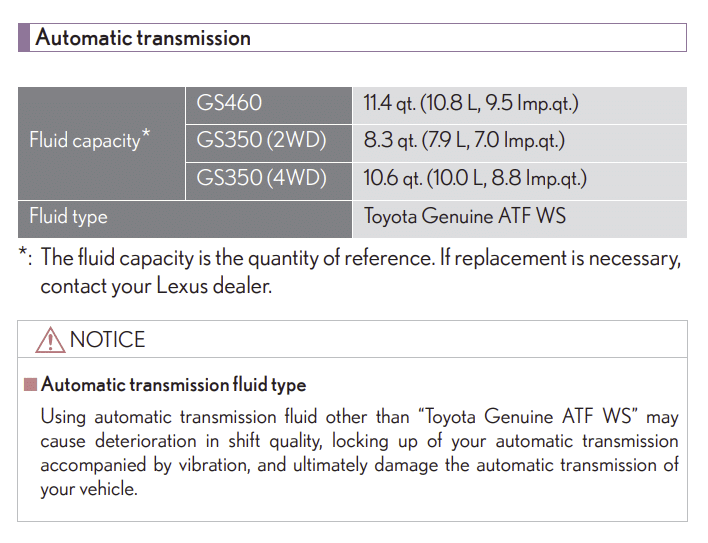The Lexus GS stands as a beacon in the luxury sedan market. Since its inception in 1993, the GS has continuously redefined luxury, seamlessly blending cutting-edge technology with uncompromising comfort. The brainchild of Toyota’s luxury division, this sedan not only exemplifies opulence but also the art of precision engineering.
Yet, like any masterpiece, it requires meticulous care to preserve its essence. One of the cornerstones of this care revolves around the transmission system. A vehicle’s transmission is much like the heart of its operation.
When well-maintained, it ensures that the power generated by the engine is smoothly and efficiently transferred to the wheels, delivering the refined driving experience that Lexus GS owners have come to love and expect.
Here’s a concise list of recommended transmission fluid types for each Lexus GS generation:
- 1st Gen (S140) 1993–1997:
- Fluid Type: Toyota Type T-IV (T4)
- 2nd Gen (S160) 1998–2005:
- Fluid Type: Toyota Type T-IV (T4)
- 3rd Gen (S190) 2006–2011:
- Fluid Type: Toyota WS (World Standard) ATF
- 4th Gen (L10) 2013–2020:
- Fluid Type: Toyota WS (World Standard) ATF
This attention to detail extends to the very lifeblood of the transmission system – the transmission fluid. It’s not just about having fluid in the system; it’s about having the right kind and the right amount. Using the correct transmission fluid is paramount for optimal performance, smoother gear shifts, and prolonging the life of the transmission.
It’s a small detail, but in luxury vehicles like the Lexus GS, it’s these small details that make a significant difference.

Lexus GS Transmission Fluid Capacity and Type
1993–1997 Lexus GS
The inaugural generation of the Lexus GS, known for setting the tone of luxury sedans for decades to come, had precise requirements for transmission fluid to ensure optimal performance.
- Fluid Capacity:
- Drain and refill: Approximately 2 quarts.
- Total fill: Roughly 8.5 to 9.0 quarts.
- Fluid Type: The recommended transmission fluid for this generation is the Toyota Type T or T-IV.
When maintaining a classic like the 1st Gen Lexus GS, always remember that using the recommended fluid type not only preserves the vehicle’s performance but also its value. Over the years, advancements in fluid technology might present newer alternatives, but it’s crucial to ensure they’re compatible with older transmission systems. Always consult with a Lexus specialist or trusted mechanic when in doubt.
1998-2005 Lexus GS
The second generation of the Lexus GS further cemented the brand’s legacy as a luxury performance vehicle. With an even more refined design and improved mechanical components, the transmission fluid requirements shifted slightly to adapt to newer transmission technologies.
| Gearbox | Fluid capacity | Fluid type |
|---|---|---|
| GS 300 5-speed A650E automatic | Total fill: 8.3-9.4 quarts (7.8-8.9 liters) Drain and refill: 2 quarts (1.8 liters) | T-IV |
| GS 430 5-speed A650E automatic | Total fill: 9.4 quarts (8.9 liters) Drain and refill: 2.1 quarts (1.9 liters) | T-IV |
The designated transmission fluid for the 2nd Gen Lexus GS is the Toyota Type T-IV. It’s vital to use this specific type to maintain optimal performance and longevity of the transmission system.
2006-2011 Lexus GS
As Lexus transitioned into the third generation of the GS series, technological advancements brought about more sophisticated transmissions. This, in turn, necessitated changes in fluid specifications to ensure that the renowned smoothness and responsiveness of the GS’s drive remained uncompromised.

| Gearbox | Fluid capacity | Fluid type |
|---|---|---|
| GS 350 6-speed A760H automatic | Total fill: 10.6 quarts (10 liters) Drain and refill: 1.9 quarts (1.8 liters) | WS |
| GS 350 RWD 6-speed A760E automatic | Total fill: 8.3 quarts (7.8 liters) Drain and refill: 1.5 quarts (1.4 liters) | WS |
| GS 430 6-speed A761E automatic | Total fill: 9.4 quarts (8.9 liters) Drain and refill: 1.9 quarts (1.8 liters) | WS |
| GS 450h L110 | Total fill: 6 quarts (5.7 liters) | WS |
| GS 460 8-speed AA80E automatic | Total fill: 11.4 quarts (10.8 liters) Drain and refill: 3.4 quarts (3.2 liters) | WS |
For this generation, the Lexus GS primarily utilized Toyota’s World Standard (WS) automatic transmission fluid. This fluid was designed to offer more extended service intervals and improved performance across a wide range of conditions.
2013-2020 Lexus GS
With the introduction of the fourth generation, Lexus pushed the boundaries of the GS series by incorporating cutting-edge design elements and pioneering technology. Such advancements were also mirrored in its mechanical and transmission systems.
| Gearbox | Fluid capacity | Fluid type |
|---|---|---|
| GS 350 8-speed AA81E automatic | Total fill: 10.6 quarts (10 liters) Drain and refill: 3.4 quarts (3.2 liters) | WS |
| GS 300 8-speed AA81E automatic | Total fill: 9.2 quarts (8.7 liters) Drain and refill: 3.4 quarts (3.2 liters) | WS |
| GS 350 6-speed A760H automatic | Total fill: 10 quarts (9.4 liters) Drain and refill: 1.7 quarts (1.6 liters) | WS |
Lexus continued with the Toyota World Standard (WS) automatic transmission fluid for the 4th Gen. This fluid is optimized for enhanced performance, smoother shifts, and prolonged transmission life.
It’s imperative for owners of the Lexus GS, especially of these newer generations, to understand that the luxury, performance, and longevity they enjoy are, in part, due to meticulous maintenance standards.
This includes the uncompromising use of the recommended transmission fluids, ensuring that the car remains a paragon of luxury motoring.
The Role of Transmission Fluid in the Lexus GS
The transmission fluid in a vehicle, particularly in a premium one like the Lexus GS, is akin to the blood in our veins – vital, irreplaceable, and often taken for granted until something goes wrong.
The function of Transmission Fluid
Primarily, transmission fluid serves as a lubricant for the myriad of parts inside the gearbox. Without it, the metal components would grind against each other, leading to premature wear, reduced efficiency, and potential failure. In automatic transmissions, this fluid also plays a crucial role in the operation of the hydraulic system, enabling smooth and timely gear shifts.
The fluid further aids in keeping the transmission at an optimal temperature. Just as our blood helps regulate our body temperature, the transmission fluid dissipates heat generated from the friction of moving parts.
This is vital for the Lexus GS, where both performance and luxury are intertwined, ensuring that the driver experiences the vehicle’s power without the distraction of a noisy or overheating transmission.
Consequences of Neglecting Transmission Fluid Needs
Using the wrong type of transmission fluid, or letting it run too low, can be detrimental to your Lexus GS.
- Wrong Fluid Type: Different transmission fluids have specific properties tailored to the needs of different transmission designs. Using an incorrect type can lead to reduced lubrication, improper cooling, and even harmful chemical reactions inside the transmission. This can result in erratic gear shifts, increased wear, and in severe cases, complete transmission failure.
- Depleted Levels: Running your GS with low transmission fluid is akin to running a marathon in a dehydrated state. The remaining fluid has to work harder, getting hotter quicker and losing its lubricating properties faster. This can cause parts to wear out at an accelerated rate, leading to costly repairs or replacements.
In both scenarios, the driver might notice symptoms such as rough or slipping gear shifts, unexplained noises from the transmission, or even warning lights on the dashboard.
To prevent such issues and to maintain the unparalleled driving experience of the Lexus GS, it’s imperative to regularly check the transmission fluid and ensure its quality and quantity align with the manufacturer’s specifications.
Procedure to Check and Replace Transmission Fluid
Maintaining the right level and quality of transmission fluid is crucial for the longevity and performance of your Lexus GS. Here’s a step-by-step guide on how to check and replace the transmission fluid:
Checking the Transmission Fluid Level and Condition
- Warm Up the Vehicle: Drive your Lexus for about 10-15 minutes to get the transmission fluid up to operating temperature. This ensures the fluid expands to its natural level.
- Park on a Level Surface: This ensures you get an accurate reading of the fluid level.
- Engage the Parking Brake: For safety reasons, always engage the parking brake.
- Check the Fluid Level:
- With the engine running and the gear in ‘Park’, remove the transmission dipstick (usually labeled and colored red).
- Wipe it clean with a lint-free cloth.
- Reinsert it fully and then pull it out again to check the level.
- The fluid should be between the “Full” and “Add” marks.
- Check the Fluid Condition:
- Fresh transmission fluid is transparent and has a reddish hue.
- If the fluid appears dark or smells burnt, it might be time for a change.
Replacing the Transmission Fluid
- Gather Necessary Supplies: Before you begin, ensure you have the correct type and quantity of transmission fluid, a large drain pan, a funnel, hand gloves, safety glasses, and the necessary tools to remove the drain plug.
- Drain the Old Fluid:
- Position the drain pan under the transmission fluid pan.
- Remove the drain plug (use safety glasses to avoid any accidental splashes).
- Let the fluid drain out completely.
- Remove the Transmission Pan (optional, but recommended for a complete change):
- Unscrew and remove the transmission pan.
- This will give you access to the transmission filter, which should be replaced at intervals specified by Lexus.
- Clean the pan thoroughly before reinstallation.
- Replace the Filter (if you’ve removed the pan):
- Remove the old filter – it usually is secured by a few screws.
- Replace it with a new one.
- Reinstall the Transmission Pan:
- Ensure the pan and the mounting surface are clean.
- Use a new gasket and secure the pan back in place.
- Refill with Fresh Transmission Fluid:
- Locate the transmission fluid fill port (it might be the dipstick tube itself).
- Using a funnel, add the recommended amount of new fluid.
- Do not overfill, as this can lead to issues.
- Check the Level Again:
- After adding the fluid, start the engine and let it run for a few minutes. Shift through the gears to circulate the fluid.
- Check the level again using the dipstick method.
- Test Drive:
- Once satisfied with the level, take your Lexus for a short drive to ensure smooth gear shifts.
- Dispose of the Old Fluid Properly:
- It’s essential to recycle or dispose of the old fluid at an authorized facility or recycling center.
Note: Always consult your owner’s manual for any model-specific procedures and fluid specifications. If you’re unsure about any steps, it’s always best to seek assistance from a professional mechanic.
Frequently Asked Questions
1. How often should I change the transmission fluid in my Lexus GS?
Answer: It’s typically recommended to change the transmission fluid every 60,000 to 100,000 miles. However, always refer to your Lexus owner’s manual for specific intervals. Factors such as heavy city driving or regular towing can affect the frequency of changes.
2. Can I use any brand of transmission fluid for my Lexus GS?
Answer: No, it’s always best to use the transmission fluid type recommended by Lexus for the specific GS generation. Using the wrong fluid can lead to transmission problems and may void any warranties.
3. Is there a difference between “checking” and “changing” the transmission fluid?
Answer: Yes. Checking refers to inspecting the fluid’s level and quality, which can be done more frequently. Changing involves draining the old fluid and refilling with new fluid, which is done at more extended intervals.
4. Why does my transmission fluid look dark or smell burnt?
Answer: Dark or burnt-smelling fluid indicates that it’s been in use for an extended period and might have collected impurities or deteriorated. It’s a sign that you should consider changing the fluid soon.
5. Can I change the transmission fluid myself?
Answer: While it’s possible to change the fluid yourself if you have the necessary tools and knowledge, it can be a messy and complicated task. If you’re unsure, it’s best to have a professional mechanic handle it.
6. I missed the recommended interval for a fluid change. Is it too late?
Answer: While it’s best to stick to recommended intervals, it’s never too late to change the transmission fluid. However, if the fluid is severely degraded, it’s essential to consult a mechanic before proceeding as the transmission might have sustained damage.
7. Does my Lexus GS have a transmission fluid filter, and should I change it?
Answer: Yes, the Lexus GS does have a transmission filter designed to trap impurities. It’s a good practice to change this filter during a full transmission fluid change to ensure optimal transmission health.
8. Can I mix old and new transmission fluid?
Answer: Ideally, no. When you change the transmission fluid, you should ensure that as much of the old fluid is drained as possible. Mixing old and new fluid can dilute the effectiveness and properties of the new fluid.
Remember, if you have any concerns or specific questions about your vehicle, consulting your Lexus owner’s manual or seeking advice from an authorized Lexus service center is always the best approach.
Conclusion
The Lexus GS, renowned for its luxurious craftsmanship and outstanding performance, truly embodies the pinnacle of automotive engineering. However, like any masterpiece, it requires meticulous care to remain at its prime. One crucial aspect of this care is the transmission system, a complex machinery responsible for the seamless power delivery we’ve come to associate with the GS.
Just as the human body requires clean blood for optimal function, the transmission system demands the right fluid in appropriate quantities. Using the correct transmission fluid not only ensures smooth gear transitions but also significantly extends the lifespan of the transmission components. On the contrary, neglecting this simple maintenance task or using sub-standard or incorrect fluid can lead to costly damages and degrade the overall driving experience.
In summary, if you cherish the unparalleled driving experience the Lexus GS offers, never underestimate the value of regular transmission maintenance. Ensure that you’re always using the right fluid, checking it at recommended intervals, and seeking professional advice when in doubt. After all, the heart of the GS’s performance lies in its transmission, and it’s only right that we treat it with the utmost respect and care.
References and Resources
For those passionate about ensuring their Lexus GS remains in top-notch condition and those curious about diving deeper into the intricacies of the vehicle, numerous valuable resources are at your disposal:
- Official Lexus Service Manuals: The most authoritative source of information for any Lexus vehicle. It offers detailed maintenance guidelines, specifications, and troubleshooting procedures. These manuals can be purchased directly from Lexus or accessed at many dealerships.
- Lexus Owners’ Online Portal: A platform where Lexus owners can manage their vehicles, access service history, and get personalized recommendations. Sign up at Lexus Drivers.
- ClubLexus: Arguably the most popular forum for Lexus enthusiasts. From DIY guides to personal experiences and advice from veteran members, this is a goldmine for any Lexus owner. Visit the forum at ClubLexus.
- Lexus GS Subreddit: A vibrant community on Reddit dedicated to the Lexus GS series. Share stories, ask questions, or browse through photos at r/LexusGS.
- YouTube: Many Lexus experts and enthusiasts share tutorials, reviews, and advice on this platform. Channels like “LexusTech” offer in-depth guides and solutions to common Lexus problems.
- Local Lexus Clubs and Groups: Many regions have local Lexus enthusiast groups that organize meets, workshops, and drive events. It’s an excellent way for owners to connect, share knowledge, and celebrate their love for the brand.
- Lexus Parts eStore: For those interested in DIY maintenance or modifications, this is the official online store for genuine Lexus parts. Browse and purchase directly at Lexus Parts eStore.
Always remember, while online resources and forums are excellent places to gather information and share experiences when it comes to critical vehicle maintenance, always consult the official service manual or seek advice from certified Lexus service centers.
















